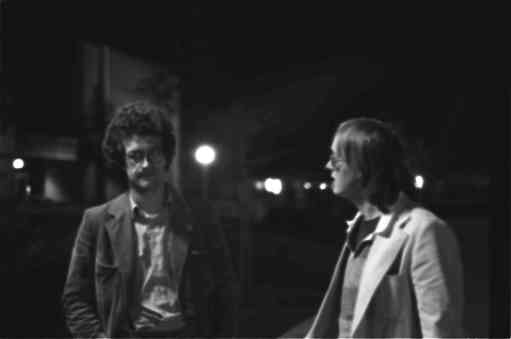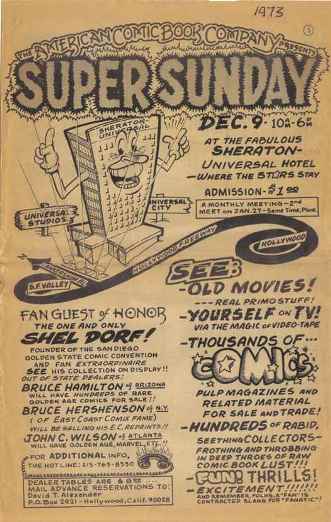In 1975, the San Diego Comic-Con committee produced two conventions: one from July 30th through August 3rd and a second from November 7th through 9th. The following is an article about that second convention. It originally appeared on November 21, 1975 in the University of California at Irvine student newspaper New University (where the author had been the editor-in-chief a year earlier). It is presented here by permission of the author.
by David Laurence Wilson
November 21, 1975
It was Saturday night when we crossed through the lobby of the El Cortez Hotel and headed towards the elevator. Steve, a 14-year old who was trying to piece together a science fair project out of about three dozen interviews, saw our comic convention identifications and called us over. “Who”, he asked, “is your favorite comic book character?”
The first weekend in November was the occasion for the San Diego Comic Con number five and a half. Rumor had it that the convention committee was trying to make back the money they’d lost during the August convention.
The August convention … you could tell it had been great from the flyer sent out to announce part II. The leaflet was decorated with pictures of the participants — Will Eisner, the creator of The Spirit; Jim Steranko, Media Scene publisher and ex-comics wonderkind; novelist and comics historian Don Rico; Ray Bradbury; and four all-stars from the Marvel Comics Company, Jack Kirby, Stan Lee, Steve Englehart, and Gil Kane. And comics. Stacks and boxes of The Avengers, Superman, Captain America, with hundreds of others.
What is it that turns people on about the comics? Is it nostalgia, fantasy or good business? Lee, my psychology student friend from Del Mar, felt it might be the individual’s projections of hopes and fears into the mass produced heroes. I thought it might be a search for a secular form of religion in the twentieth century.
When Steve stopped us we were headed towards the hotel’s Starlight Room. The action at the convention had dwindled to a few old Boris Karloff films in the Mediterranean Room. At its best, the weekend was a repeat of the August show. Jack Kirby, the cigar smoking artist, was once again surrounded by a coterie of youthful admirers. Kirby, who has created more characters than anyone else in the business, started young and has spent almost forty years drawing characters like Captain America, The Manhunter, The Challengers of the Unknown, and The Thing. Always a nice guy, Kirby signed copies of the comics he’d produced, comics he had never worked on, and he offered encouragement to the kids who gathered together in clusters to draw copies of his characters.
Don Rico, who was Mickey Spillane’s editor when Spillane was still a struggling comics writer, drove down from Hollywood for his Saturday afternoon talk. Rico, who is teaching a comics course at UCLA, had knocked off work on his new illustrated novel project just a few hours earlier.
Upstairs, in the Dealer’s Room, the action was hot and heavy. California comic dealers from San Diego to San Francisco paid $20 a table for the opportunity to display their vintage comics. And comics weren’t all. Photographs and posters of the Star Trek crew, science fiction books, and pulp novels shared the space with the comics. The prices ranged from the 10 cent comics from the thirties that were going for two or three hundred dollars, to the 25 cent comics from the seventies with six or seven copies going for a dollar. One collector rushed out into the lobby with a #4 Avengers from the mid-sixties — he waved the torn comic in front of a friend — “I got this for only $2.50. If I fix it up, it will be worth at least $10!”
Between the rows of comics, the thousands of comics, the Dealers set up displays of original comic art. The art from a late thirties Sunday comic strip of Rudolph Dirks’ “The Captain and the Kids” went for $40. Jerry Muller, who operates the largest animation art business in the world from his Orange County home, was selling the original animation cells from Yellow Submarine for another $40 each. Nine pages of Captain American art went for only $135. The cover from a “Frankenstein’s Monster” comic, by the popular Marvel artist Berni Wrightson, was at another table. The dealer said he couldn’t let it go for anything less than $90.
The comic books, too, were ranked by the popularity of their artists. Besides Wrightson, the comics were divided into titles drawn by Neal Adams and Barry Smith. Smith’s Conan The Barbarian comics were among the most sought after comics, despite their recent dates.
To some very real extent, the comic book market is inflated, pushing itself up a notch or two on the money scale at every convention. The original art business, where a few key series like The Captain and the Kids and Lil’ Abner are available, is still likely to climb. The comic books, though, are probably at the highest prices the market will bear for some time. The prices are already beginning to push the buyers out of the market. An old, torn, comic for $50, $60?? For the same bills you can get 240 comics at the newsstand. As one dealer complained on Friday night, “So far it’s been a big fat bore.”
The comics’ prices are regulated by the Buyers Guide, a printed institution like coin collecting’s Red Book. Both dealers and fans wandered past the rows of comics, their well-thumbed guides at their sides.
The convention was definitely small-time. After the San Diego Convention in August, another major convention was held up in Berkeley, where most of the Bay area underground comics artists showed up. San Diego Con, Part II, was strictly a local event. Jerry Muller did less than a tenth of the business he did at the large New York Comics Convention, and about a fifth of the business from the San Diego Convention in August.
More than anything else, though, the conventions are fun, a rare place where the comic fans can get together and discuss, in serious terms, the relative merits of, say, Superman and Spiderman. The ages vary, but the population is at least 85% male. “These people are amazing,” Don Rico said. “They’ll know who produced all those old comics, even when the credits weren’t listed. It’s a very educated audience.”
The convention may be turning into too much of a good thing. Between San Diego, Berkeley, and San Diego, Part II, that’s three conventions in four months, with more scheduled to come. A Star Trek-Comic-Adventure Hero Convention is being planned for San Diego next Spring, and both Jerry Muller, and Berkeley’s Clay Geerdes, the editor of Comix World, have said they’d like to try and put together their own conventions. Two or three conventions are great occasions, but if a few more get started, there’s probably a lot of fans who will decide to stay home, save their money, and watch the reruns of Star Trek or The Six Million Dollar Man.
The events scheduled at a comic convention are usually dissimilar and exotic, linked together only by the fervor of the fans and collectors. Up on stage, artists are followed by karate stars, magicians, films and editors. San Diego featured an eclectic cast: Jack Kirby, Tarzan, The Rebel Without a Cause, Karate, Superman, and Boris Karloff. The artwork for the convention featured Lon Chaney’s Phantom of the Opera looking over the Silver Surfer’s shoulder.
The best moments of Comic Con Part II, came when Jack Kirby approached the stage to reminisce about the Golden comic age, 1935-1945, and then the beginnings of the Marvel Company around 1960. When it came to questions, the audience was equally interested in Kirby’s current plans for Captain America, the Silver Surfer, and a few other assorted characters. Another high point was when David Smith, the archivist of the Disney Studios, showed up with an armload of Disney animation films. The popularity of the films — Steamboat Willie, The Band Concert, and a wartime short with Donald Duck — led everyone to wonder when the shorts might be rereleased.
For many of the kids who attended the convention, the weekend was marked as a success if they collected another Kirby signature or if they managed to fill a hole in their comic collections. The older fans went after more esoteric pieces of information, but they were equally star struck in the company of the comic giants.
Back in the lobby, Steve, the budding Gallop, wanted us to finish his questionnaire. He asked us the questions. “C’mon,” he encouraged us, “who is your favorite hero?”
“How many comics do you own?”
“How often do you go to these conventions?”
“How long have you been reading comics?”
“What do you think of the questionnaire?”
Steve wrote down the answers in as fast a scribble as he could manage. After the last question, he paused. “Is that it?” we asked.
“Well,” he said, pulling out a briefcase and uncoupling the catch, “would you like to buy some comics?”
We told him no and took the elevator all the way up to the Starlight Room.

Author David Wilson (right) and German film director Wim Wenders from the mid-seventies
David Laurence Wilson is a San Diego native whose consistent journey north has left him in the California Gold Country, where he’s found a house big enough for a wife, two kids and lots of books and comics. David grew up in the ‘fifties. Comic books were always a treat – so were Sunday comics sections. In 1961 his mother reluctantly allowed him to buy a Mad annual and Fantastic Four #1 at the drugstore beside Bullock’s Wilshire. A life-changing experience indeed!
Wilson began attending the San Diego convention during the early ‘seventies while attending college in Orange County. During the nineteen eighties he began exhibiting designs from his rubber stamp company, Ready-Made Rubber, featuring the talents of Rick Geary, Moebius, Bob Crabb, Dan Piraro, Roger Langridge, Geof Darrow, J. R. Williams, Eric Bowman and others.
Wilson has written for many newspapers and magazines, even contributing a handful of gags for the “Bizarro” comic panel. Most recently Wilson has contributed biographical introductions for the Stark House Press “Noir Classics” series, contributing essays on the crime fiction masters Harry Whittington, Gil Brewer and W. R. Burnett. He wrote about the San Diego writing scene in his essays on Wade Miller and A. S. Fleischman.
Since 1985 Wilson has missed the San Diego convention twice: first when he was above the Arctic Circle in Norway’s Lofoten Islands, site of Edgar Allan Poe’s “Descent Into the Malestrom”, and second, for cancer surgery.
Wilson says: Let’s hear it for early detection, folks. No one is going to die because their cancer was diagnosed too early! Health care should be a right in civilized societies.
